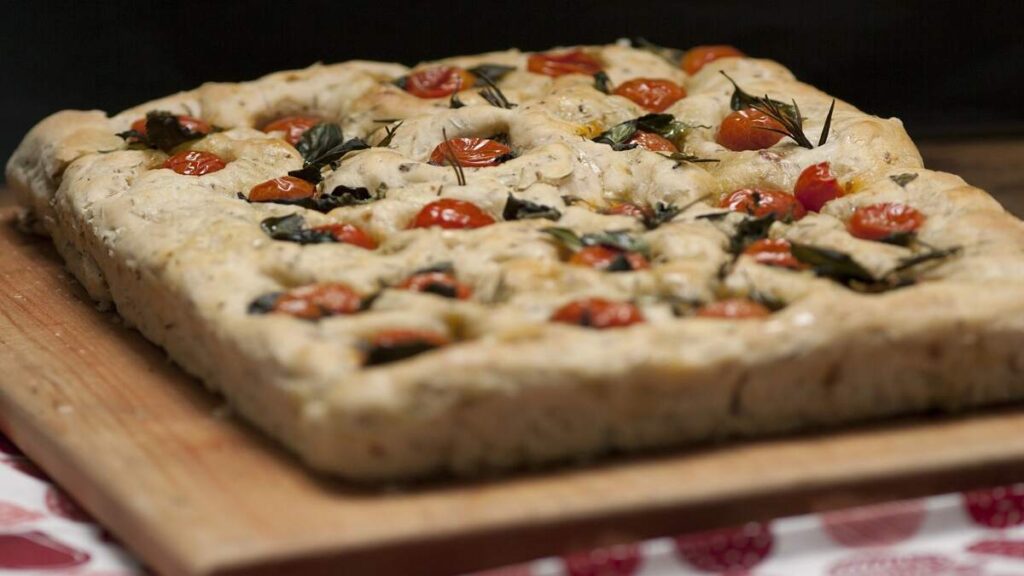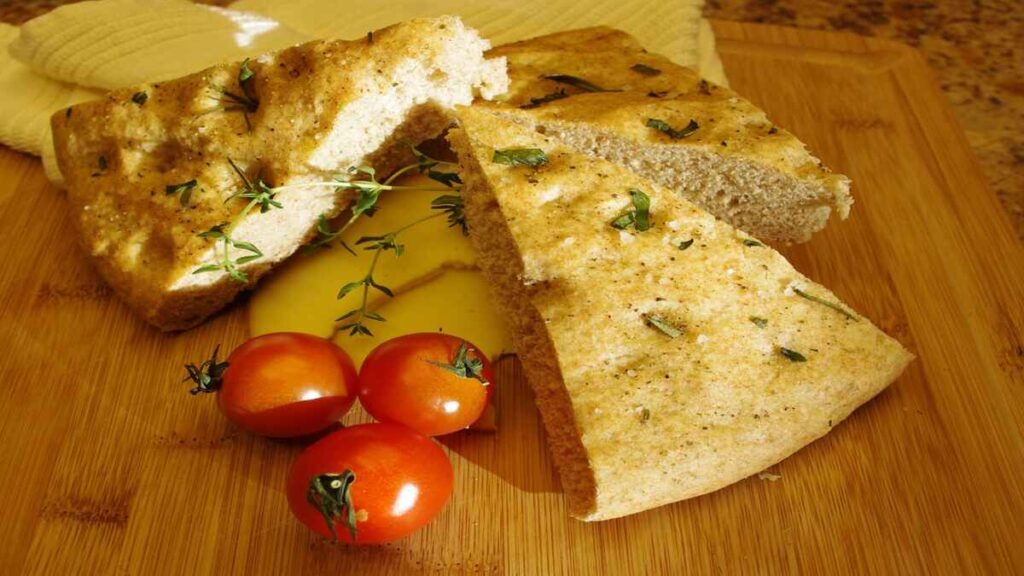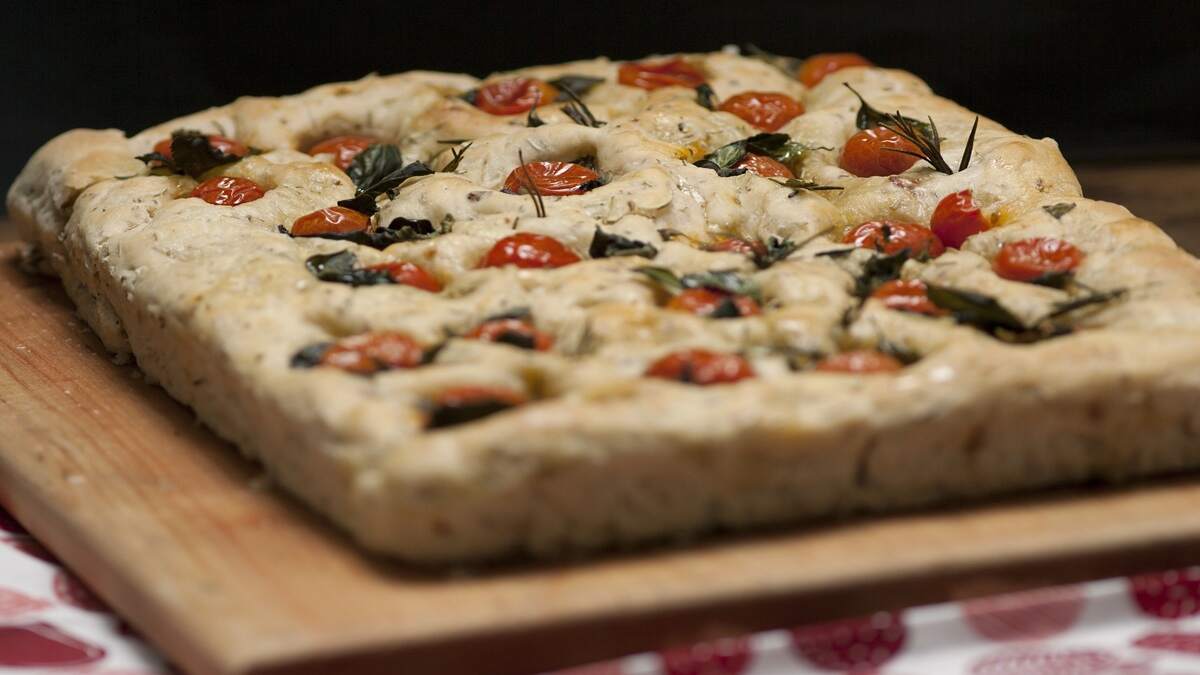Focaccia Recipe is not just a bread—it’s a masterpiece of Italian baking that embodies simplicity, flavor, and versatility. Known for its golden crust, airy interior, and savory toppings, focaccia is a treat for both casual meals and sophisticated gatherings. Whether enjoyed as a snack, a side, or the base of a sandwich, focaccia never fails to impress.
In this comprehensive guide, we’ll explore what focaccia is, its origins, how to make it step by step, its nutritional benefits, and the best ways to serve it.

What Is Focaccia Recipe?
Focaccia Recipe is a traditional Italian flatbread, often likened to a cousin of pizza dough. It is typically flavored with olive oil, salt, and a variety of toppings such as rosemary, cherry tomatoes, or olives. With its characteristic dimpled surface, focaccia is known for being soft and fluffy on the inside while boasting a crisp, golden exterior. It can be sweet or savory, making it an incredibly versatile bread.
The Origin of Focaccia Recipe
Focaccia Recipe has ancient roots, tracing back to the Roman Empire. The name “focaccia” is derived from the Latin word focus, meaning “hearth,” as it was traditionally baked on hot stones or hearths. Over time, the recipe evolved, with regional variations emerging throughout Italy. Liguria, a coastal region in northwestern Italy, is particularly famous for its focaccia, often seasoned with olive oil and sea salt.
Ingredients Needed for Focaccia Recipe
To make authentic focaccia, you’ll need these simple ingredients:
- Flour: All-purpose or bread flour works best.
- Water: Lukewarm water helps activate the yeast.
- Yeast: Active dry yeast or instant yeast ensures a good rise.
- Sugar: A small amount to feed the yeast.
- Salt: Enhances flavor.
- Olive Oil: The cornerstone of focaccia’s flavor and texture.
- Optional Toppings: Fresh rosemary, cherry tomatoes, olives, garlic, onions, or cheese.
Equipment You’ll Need
- Mixing Bowls: For combining and proofing the dough.
- Measuring Cups and Spoons: To ensure precise ingredient quantities.
- Wooden Spoon or Stand Mixer: For mixing the dough.
- Baking Pan or Sheet: A 9×13-inch pan is ideal for focaccia.
- Clean Kitchen Towel or Plastic Wrap: To cover the dough during proofing.
- Oven: Preheated for even baking.
Step-by-Step Preparation of Focaccia Recipe
Step 1: Prepare the Yeast Mixture
In a small bowl, combine 1 cup of lukewarm water, 1 teaspoon of sugar, and 1 packet of active dry yeast. Let it sit for 5–10 minutes until frothy, indicating the yeast is activated.
Step 2: Mix the Dough
In a large mixing bowl, combine 3 cups of all-purpose flour, 1 teaspoon of salt, and the yeast mixture. Add 2 tablespoons of olive oil and mix until a shaggy dough forms.
Step 3: Knead the Dough
Turn the dough onto a floured surface and knead for about 8–10 minutes until smooth and elastic. Alternatively, use a stand mixer with a dough hook for 5 minutes.
Step 4: Proof the Dough
Place the dough in a lightly oiled bowl, cover with a clean kitchen towel or plastic wrap, and let it rise in a warm place for 1–2 hours, or until it doubles in size.
Step 5: Shape the Dough
Grease a 9×13-inch baking pan with olive oil. Transfer the dough to the pan and gently stretch it to fit. Cover and let it rise for another 30 minutes.
Step 6: Create the Signature Dimples
Drizzle olive oil generously over the dough. Using your fingers, press down into the dough to create dimples. Sprinkle it with sea salt, fresh rosemary, or any desired toppings.
Step 7: Bake the Focaccia
Preheat the oven to 425°F (220°C). Bake the focaccia for 20–25 minutes, or until the top is golden brown and crispy.
Step 8: Cool and Serve
Let the focaccia cool for 5–10 minutes before slicing. Serve warm or at room temperature.
Some Health Benefits of Focaccia Recipe

- Rich in Healthy Fats: Olive oil is a key ingredient in focaccia, providing heart-healthy monounsaturated fats.
- Energy Boost: The carbohydrates in focaccia offer a quick source of energy.
- Versatile Nutritional Additions: Adding vegetables or seeds as toppings can enhance the fiber and nutrient content.
- Low Sugar Content: Traditional focaccia is low in sugar, making it a healthier bread choice.
Additional Information about Focaccia Recipe
- Regional Variations: In Liguria, focaccia is often thin and crispy, while in Puglia, it includes potatoes in the dough for a softer texture.
- Sweet Focaccia: Swap savory toppings for sugar, honey, or fruits like figs for a dessert version.
- Storage: Wrap leftover focaccia in foil or store it in an airtight container. It stays fresh for 2–3 days. Reheat in the oven for the best results.
- Freeze-Friendly: Focaccia freezes well. Slice it, wrap it tightly, and freeze for up to 3 months.
Best Ways to Serve Focaccia Recipe
Focaccia is incredibly versatile and can be served in many ways:
- As a Side Dish: Pair with soups, stews, or pasta dishes like lasagna.
- For Sandwiches: Slice focaccia horizontally and use it as sandwich bread.
- With Dips: Serve alongside hummus, olive tapenade, or balsamic vinegar and olive oil.
- For Breakfast: Toast it lightly and spread with butter or jam.
- As a Pizza Base: Top with tomato sauce, mozzarella, and your favorite toppings for a focaccia pizza.
Calories, Prep Time, and Cook Time
- Calories: One serving of focaccia (about 50g) contains approximately 150–180 calories, depending on toppings.
- Prep Time: 20 minutes (active) + 2 hours (proofing)
- Cook Time: 20–25 minutes
Conclusion
Focaccia is a bread that combines simplicity with elegance. Its soft, flavorful interior and crispy, golden crust make it a crowd-pleaser that fits any occasion. Whether you’re a novice baker or a seasoned chef, focaccia is a rewarding recipe to master, offering endless possibilities for toppings and serving styles. With just a few ingredients and steps, you can bring the taste of Italy to your kitchen.
FAQs
1. Can I make focaccia without yeast?
Yes, you can use baking powder or sourdough starter as alternatives, but the texture will differ slightly.
2. What’s the best flour for focaccia?
All-purpose or bread flour works well. For a softer texture, you can mix in some cake flour.
3. How do I keep focaccia fresh?
Store it in an airtight container at room temperature for 2–3 days. Reheat in the oven for the best texture.
4. Can I add toppings before baking?
Absolutely! Popular toppings like olives, onions, tomatoes, and rosemary should be added before baking to infuse the bread with flavor.
5. Is focaccia gluten-free?
Traditional focaccia is not gluten-free, but you can make it with gluten-free flour blends designed for baking.
